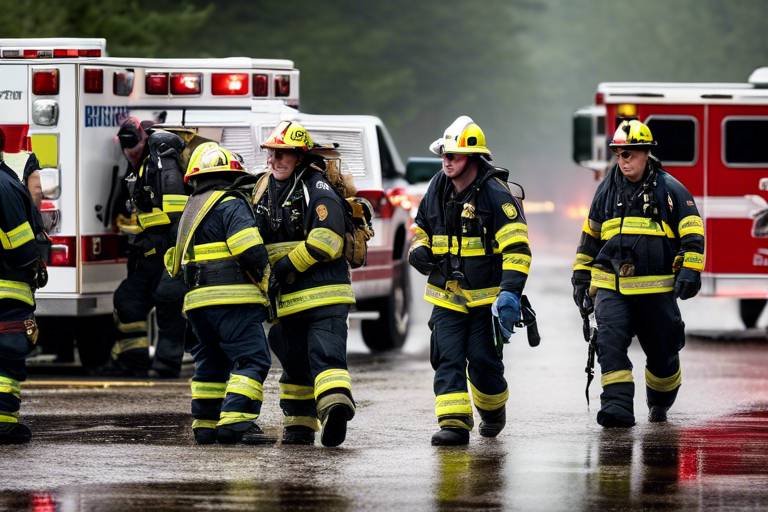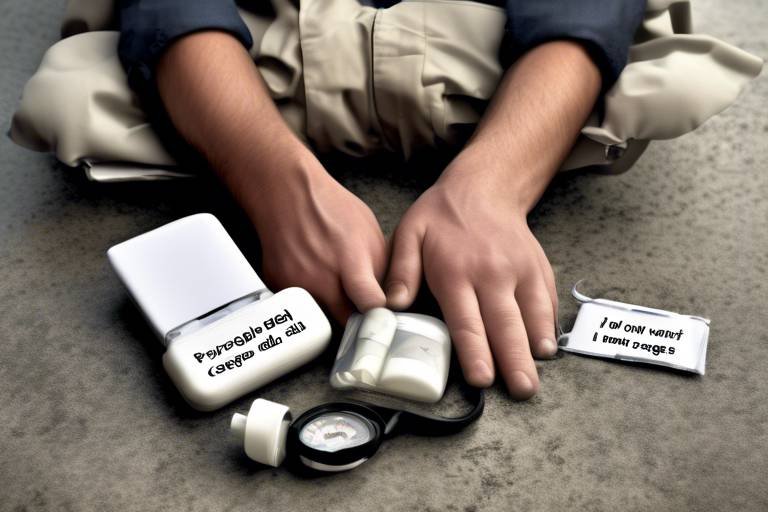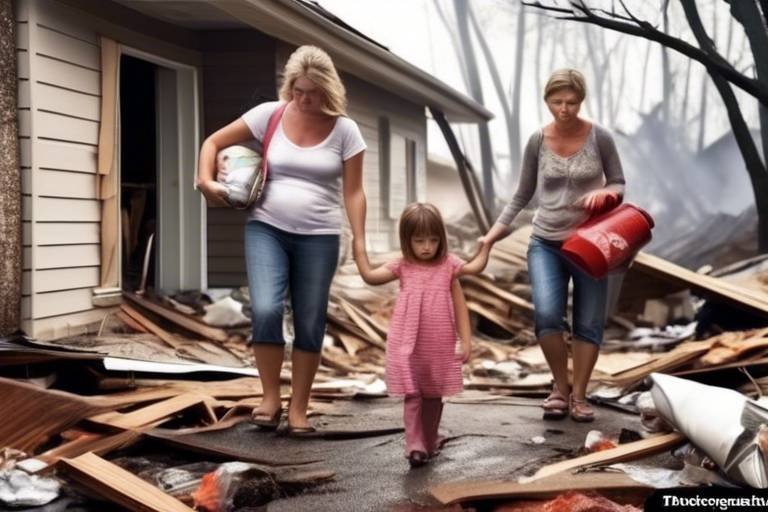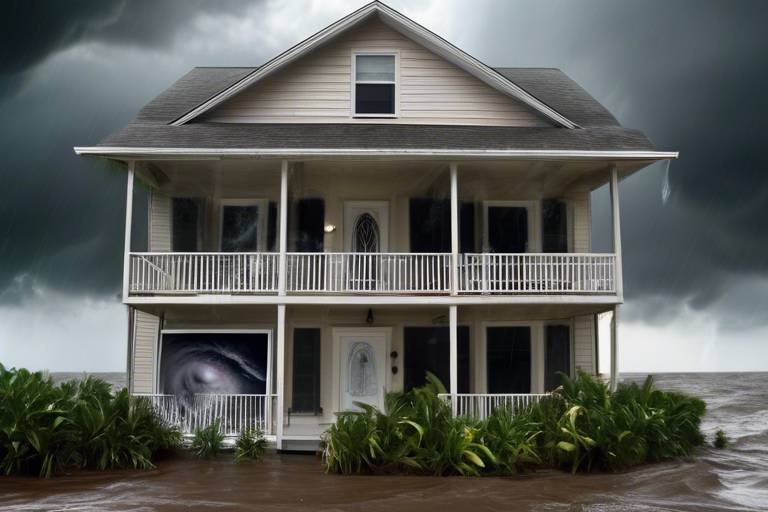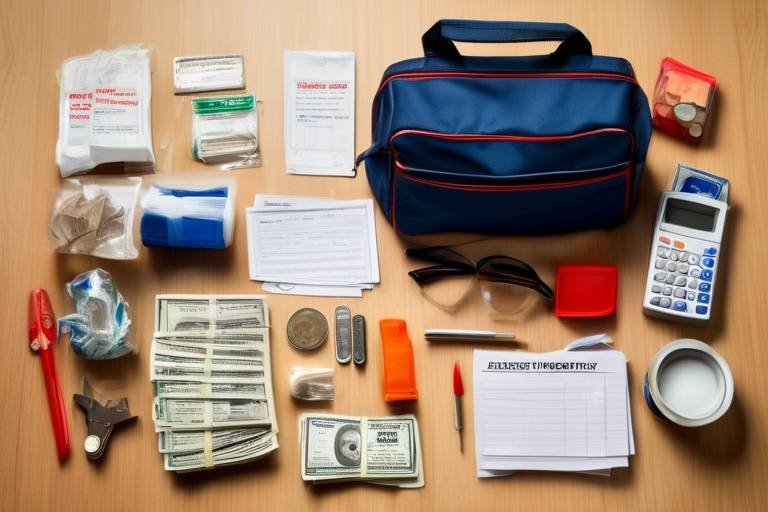How to Ensure Fire Safety in Your Home during Disasters
When it comes to keeping your home safe, especially during disasters, fire safety should be at the top of your list. Imagine the chaos of a fire breaking out while you're trying to manage other emergencies—it's a nightmare scenario that no one wants to face. This article provides essential tips and guidelines for maintaining fire safety in your home during disasters, ensuring you and your loved ones are prepared for emergencies. By understanding potential risks and implementing proactive measures, you can create a safer environment for everyone.
Identifying common fire hazards in the home is crucial. Have you ever thought about what could spark a fire in your living space? It could be something as simple as a forgotten candle, frayed electrical wires, or even the buildup of lint in your dryer. This section explores potential risks and how to mitigate them effectively to ensure a safer living environment. Regularly checking your home for these hazards is like doing a health check-up for your house—it's essential for long-term safety.
Developing a comprehensive emergency plan helps families respond efficiently during a fire. Think of it as your family's playbook in case of an emergency. This section outlines key components of an effective plan that everyone should know. From assigning roles to each family member to establishing communication methods, having a plan can make all the difference in a crisis. Remember, when the smoke rises, panic can set in quickly, but a well-prepared family can act swiftly.
Designing clear escape routes from every room in your home is vital. Picture this: you wake up to the smell of smoke and need to get out fast. Do you know the quickest way to safety? This section discusses how to create and practice these routes with your family. Make sure everyone knows at least two ways out of each room, and don’t forget to keep exits clear of clutter. Practicing these routes can help everyone stay calm and collected during an emergency.
Conducting regular fire drills prepares everyone for an emergency. Just like athletes practice their plays, your family should rehearse their escape plan. This part emphasizes the importance of practice and how to make drills engaging for all family members. Consider setting up a fun competition to see who can get to the meeting point the fastest. Not only does this build familiarity with the plan, but it also adds an element of teamwork.
Teaching children about fire safety is essential. Kids can be curious and sometimes reckless, so it’s crucial to involve them in safety discussions and drills. This section provides tips on how to involve kids in safety discussions and drills, making them aware of potential dangers. Use stories or games to explain the importance of fire safety, and encourage them to ask questions. The more they understand, the safer they will be.
Effective communication during a fire can save lives. Establishing a designated meeting place outside your home is key. This section highlights the importance of having a designated meeting place and methods for contacting each other. Make sure everyone knows where to go and how to reach out to one another, whether it’s through a phone call or a text message. In the chaos of a fire, knowing where to meet can prevent confusion and ensure everyone is accounted for.
Proper fire safety equipment can significantly reduce risks. Think of smoke detectors and fire extinguishers as your home’s first line of defense. This section covers essential devices like smoke detectors, fire extinguishers, and their maintenance. Regularly check your smoke detectors to ensure they’re functional—after all, a detector that doesn’t work is like a lifeguard who can’t swim. Make it a habit to change the batteries at least once a year or when you change your clocks for daylight saving time.
Selecting appropriate smoke detectors for your home is crucial. There are various types available, including ionization detectors, photoelectric detectors, and dual-sensor detectors. This part explains different types and their specific features to enhance safety. For instance, ionization detectors are great for detecting fast-flaming fires, while photoelectric detectors are better for smoldering fires. Understanding these differences can help you choose the right detectors for your unique living space.
Understanding how to maintain and use fire extinguishers can help in emergencies. Regular checks for pressure and expiration dates are essential to ensure they function when needed. This section provides guidelines on proper upkeep and usage techniques. Remember, using a fire extinguisher is a skill that requires practice; consider taking a class to familiarize yourself with different types and their applications. Knowing how to handle one can empower you to act quickly in a critical situation.
- How often should I check my smoke detectors? It’s recommended to check them monthly and change the batteries at least once a year.
- What should I do if my fire alarm goes off? Stay calm, evacuate immediately, and call emergency services once you are safe.
- How can I teach my children about fire safety? Use stories, games, and practice drills to make learning about fire safety fun and engaging.

Understanding Fire Risks
When it comes to ensuring the safety of your home, understanding fire risks is absolutely essential. Many people might think that fires are something that only happen to others, but the truth is, fire hazards can lurk in the most unsuspecting places. From the kitchen to the garage, there are common fire hazards that every homeowner should be aware of. By identifying these risks, you can take proactive steps to mitigate them and create a safer living environment for you and your loved ones.
One of the most significant fire risks in any home is the kitchen. With all the cooking, frying, and baking that happens in this space, it’s no surprise that nearly half of all home fires start in the kitchen. Grease buildup, unattended cooking, and malfunctioning appliances can all lead to dangerous situations. It's crucial to keep your kitchen clean and to never leave cooking food unattended. Remember, a simple distraction can turn into a fire emergency in a matter of minutes!
Another often-overlooked risk is related to electrical systems. Faulty wiring, overloaded outlets, and frayed cords can create a perfect storm for a fire. If you notice any flickering lights or frequently tripped circuit breakers, it’s a sign that you should call a professional electrician to inspect your system. Additionally, be mindful of how you use extension cords; they are meant for temporary use and can easily overheat if left plugged in for too long.
In the living room, flammable materials such as curtains, furniture, and decorative items can pose a risk, especially if they are placed too close to heat sources like lamps or heaters. It’s essential to maintain a safe distance between these items and any heat-producing appliances. In fact, having a fire extinguisher nearby can be a lifesaver should an accident occur.
Moreover, the garage is another hotspot for fire risks. With gasoline, paints, and other flammable materials often stored there, it’s important to keep these items away from heat sources and to ensure proper ventilation. A good rule of thumb is to store these items in fireproof containers and to regularly check for leaks or spills that could ignite.
To summarize, here are some common fire hazards to keep an eye on:
- Kitchen: Unattended cooking, grease buildup, faulty appliances
- Electrical systems: Faulty wiring, overloaded outlets, frayed cords
- Living room: Flammable materials near heat sources
- Garage: Flammable liquids and poor ventilation
By being aware of these risks and taking steps to mitigate them, you can significantly decrease the likelihood of a fire in your home. Regularly assess your living space for potential hazards, and don’t hesitate to make necessary changes or call in professionals when needed. Remember, preparation is key, and understanding fire risks is the first step in ensuring the safety of your home and family.
Q: What are the most common causes of house fires?
A: The most common causes include cooking accidents, electrical failures, heating equipment, and smoking materials.
Q: How often should I check my smoke detectors?
A: It’s recommended to check your smoke detectors at least once a month and replace the batteries twice a year.
Q: What should I do if a fire breaks out in my home?
A: Evacuate immediately, call 911, and do not attempt to extinguish the fire unless it is small and manageable.
Q: How can I teach my children about fire safety?
A: Involve them in safety discussions, practice escape routes, and explain the importance of not playing with fire.

Creating an Emergency Plan
When it comes to fire safety, having a well-thought-out emergency plan is not just a good idea—it's a necessity. Imagine this: a fire breaks out in your home. Panic sets in, and without a clear plan, chaos ensues. But with a solid emergency plan in place, you can transform that chaos into a well-orchestrated escape. It’s like having a map in a treasure hunt; without it, you’re just wandering aimlessly.
To start, gather your family and discuss the potential fire risks in your home. Understanding these risks is the first step in crafting a comprehensive emergency plan. You should cover everything from the kitchen (where most house fires start) to the garage (where flammable materials may be stored). The goal is to ensure everyone knows where the dangers lie and how to avoid them.
Next, outline the key components of your emergency plan. Here are some essential elements you should include:
- Escape Routes: Designate clear escape routes from every room in your home. Make sure everyone knows how to exit quickly and safely.
- Meeting Spot: Choose a safe meeting place outside your home where everyone can gather after escaping. This will help you account for everyone and prevent anyone from re-entering the house.
- Communication Methods: Establish how you will communicate during a fire. Whether it’s a group text or a phone call, make sure everyone knows how to reach each other.
Once you have these components laid out, it’s essential to practice your emergency plan regularly. Think of it like practicing for a school play; the more you rehearse, the more confident and prepared you’ll feel. Regular drills not only help reinforce the plan but also reduce panic during an actual emergency.
Involving your children in the planning process can make a huge difference. Kids are often more resilient and adaptable than we give them credit for. By teaching them about fire safety and involving them in drills, you empower them with the knowledge they need to stay safe. It’s like giving them a superhero cape; they might feel invincible, but they also understand the importance of safety.
In summary, creating an emergency plan isn’t just about writing down a few steps; it’s about fostering a culture of safety in your home. By identifying risks, outlining escape routes, and practicing regularly, you can ensure that your family is prepared for any fire emergency that may arise. So, gather your loved ones, discuss your plan, and turn those potential panic moments into a well-rehearsed performance.

Establishing Escape Routes
When it comes to fire safety, establishing clear and efficient escape routes in your home is not just a good idea—it's a necessity. Imagine waking up in the middle of the night to the smell of smoke. Panic can easily set in, and knowing exactly where to go can be the difference between safety and tragedy. To ensure that everyone in your household knows how to escape quickly and safely, it’s crucial to map out these routes ahead of time.
Start by examining your home’s layout. Identify all possible exits, including doors and windows. Make sure to consider the following key points:
- Multiple Routes: Every room should have at least two ways to exit, if possible. This could mean a door and a window or two doors that lead to different areas of the house.
- Obstruction-Free Pathways: Ensure that escape routes are clear of furniture and other obstacles. A cluttered path can slow down evacuation and put lives at risk.
- Low Smoke Zones: Teach your family to stay low to the ground during a fire, as smoke rises. This means that escape routes should ideally lead to areas with minimal smoke accumulation.
Once you've identified these routes, it's time to create a visual representation. A simple floor plan can be drawn on paper, marking each escape route clearly. Hang this plan in a visible area, such as on the refrigerator or a bulletin board. This way, everyone can familiarize themselves with the routes without having to memorize them. But don’t stop there—practice makes perfect!
Conduct regular family drills to ensure everyone knows how to react in case of a fire. These drills should mimic real-life scenarios as closely as possible. For example, you might simulate a fire in one area of the house and have everyone use their designated escape routes. Encourage your family members to time themselves during these drills to add an element of urgency. It’s not just about knowing where to go; it’s about getting there fast!
Involving children in these drills can also make them feel more secure. Explain the importance of fire safety in a way that resonates with them. Maybe turn it into a game where they have to find the fastest way out of the house. This not only teaches them the routes but also instills a sense of responsibility and awareness regarding fire safety.
Finally, designate a meeting spot outside your home where everyone can gather after escaping. This should be a safe distance away from the house, such as a neighbor’s yard or a tree on the street. This way, you can quickly account for everyone and ensure that no one has gone back inside to retrieve belongings, which can be extremely dangerous.
Remember, the goal is to create a plan that everyone understands and can execute without hesitation. Establishing escape routes is not just about safety; it’s about peace of mind. Knowing that you have a plan in place can significantly reduce anxiety during a potential disaster.
Q: How often should we practice our escape routes?
A: It’s recommended to practice your escape routes at least twice a year. This keeps the information fresh in everyone’s minds and helps identify any changes needed in your plan.
Q: What should we do if we encounter smoke while escaping?
A: If you encounter smoke, remember to stay low to the ground where the air is clearer. If possible, cover your nose and mouth with a cloth to help filter out smoke.
Q: Can we use elevators during a fire?
A: No, never use elevators during a fire. Always use the stairs to escape, as elevators can malfunction or become inoperable due to smoke or fire.
Q: What if someone in our family has mobility issues?
A: Make special arrangements for individuals with mobility issues. Consider assigning someone to assist them during drills and in case of a real emergency.

Regular Drills
When it comes to fire safety, are not just a good idea; they are a necessity. Imagine this: a fire breaks out in your home, and chaos ensues. Would your family know what to do? Would they remember the escape routes? Regular fire drills can be the difference between safety and disaster. By practicing your emergency plan, you ensure that everyone knows their role and can act swiftly when it counts the most.
Conducting these drills should not feel like a chore. You can turn them into a fun family activity! Set a specific day each month to conduct your fire drills. Make it a game: time how quickly everyone can get out of the house and to your designated meeting point. This not only builds familiarity but also encourages teamwork among family members. Kids love challenges, and what better way to teach them about fire safety than making it exciting?
In addition to practicing escape routes, consider simulating different scenarios. For example, what if the smoke detector goes off in the middle of the night? Or what if a family member is in a different part of the house? Creating various scenarios can help everyone think critically and adapt to unexpected situations. You can even use props like a smoke machine to mimic smoke and make the drill more realistic. Remember, the goal is to prepare your family for any situation, so the more realistic the drill, the better.
It’s also important to keep the conversation open. After each drill, gather your family and discuss what went well and what could be improved. This reflection helps everyone feel involved and valued in the process. Encourage your children to express their feelings about the drills. Are they scared? Confident? Understanding their emotions can help you address any fears and reinforce the importance of fire safety.
Lastly, don’t forget to include pets in your drills! They are part of the family too, and knowing how to safely evacuate them can save lives. Designate a family member to be responsible for pets during an emergency. This way, everyone has a role, and no one is left behind. Regular drills not only prepare your family for emergencies but also foster a sense of unity and preparedness that can extend beyond fire safety.
- How often should we conduct fire drills? It's recommended to practice fire drills at least once every three months to keep everyone familiar with the procedures.
- What should we do if a family member is not home during a drill? Establish a plan for how to communicate and coordinate in case someone is not at home during an emergency.
- Can we use a fire safety app? Yes! There are several apps available that can help you create and practice your emergency plan, as well as remind you of drill schedules.
- What age is appropriate to start involving children in fire drills? Children as young as three can start learning about fire safety, but it's important to tailor the information to their level of understanding.

Involving Children
When it comes to fire safety, involving children can make a world of difference. Kids are naturally curious, and their willingness to learn can be harnessed to create a safer environment for everyone in the home. By teaching them about fire safety, you’re not just preparing them for emergencies; you’re instilling lifelong habits that can save lives. Have you ever thought about how much kids absorb when they’re engaged in a fun and interactive way? That's why it's essential to incorporate learning into play.
Start by having open discussions about fire safety. Use simple language and relatable examples. For instance, you could compare fire to a dragon that can be both useful and dangerous—just like a dragon can cook your food but also burn your house down if not handled properly. This analogy helps children understand the dual nature of fire and its potential hazards.
Next, consider organizing family fire drills. Make it a fun event! You could turn it into a game where you time how fast everyone can get to the designated meeting spot outside. This not only makes the drill enjoyable but also reinforces the importance of knowing what to do in case of an emergency. Remember, the more they practice, the more prepared they’ll be.
Additionally, you can create a fire safety kit together. Involve your children in selecting items for the kit, such as a flashlight, a whistle, and a first-aid kit. Explain the purpose of each item, and let them take ownership of their safety gear. This not only teaches responsibility but also empowers them to act should a fire occur.
Moreover, storytelling can be a powerful tool. Share age-appropriate stories or videos that highlight fire safety. Discuss the lessons learned from these stories and how they can apply them in real life. You could even create a story together, featuring your family as the heroes who successfully escape a fire by following the safety rules. This creative approach can make the lessons stick!
Finally, encourage your children to ask questions. Be open and patient, answering their queries as thoroughly as possible. This dialogue not only clarifies their doubts but also reinforces their understanding. Remember, children learn best when they feel safe and supported, so create an atmosphere where they feel comfortable discussing their fears and concerns regarding fire safety.
By actively involving children in fire safety education, you’re not just teaching them to react in an emergency; you’re equipping them with the knowledge and skills they need to make safe choices throughout their lives. After all, safety starts at home, and it’s a team effort!
- What age should I start teaching my child about fire safety? It's never too early to start! Begin with simple concepts as soon as they can understand basic safety rules.
- How often should we conduct fire drills? Aim for at least twice a year to keep everyone fresh on the procedures.
- What should be included in a fire safety kit? Essential items include a flashlight, whistle, first-aid supplies, and a list of emergency contacts.

Communication Strategies
When it comes to fire safety, establishing effective can be a lifesaver. Imagine the chaos that can ensue during a fire—smoke filling the air, alarms blaring, and panic setting in. In such moments, having a plan for how your family will communicate can make all the difference. First and foremost, it’s essential to designate a specific meeting place outside your home where everyone knows to go in case of an emergency. This could be a tree, a neighbor's house, or any location that is a safe distance from the flames. By having a clear meeting point, you can quickly account for everyone and avoid unnecessary searching.
Additionally, consider the various methods of communication that might be needed. In a fire situation, traditional means like cell phones may not always be reliable due to power outages or network overloads. Therefore, it’s wise to have a backup plan. For instance, you could establish a code word that all family members know. This code word can be used to signal that everyone is safe or to alert someone if they are in danger. Moreover, ensure that every family member understands how to use their phone to call 911 or the local emergency services, as well as how to send a text message in case voice calls are not possible.
Another vital aspect of your communication strategy should include regular discussions about fire safety. Make it a family affair! Gather everyone around the dinner table or during a family game night to talk about what to do in case of a fire. This not only helps to reinforce the plan but also gives everyone a chance to ask questions and voice concerns. Children, in particular, may have unique perspectives or fears that need to be addressed. By fostering an open dialogue, you create an environment where everyone feels empowered and informed.
Lastly, consider creating a visual aid that outlines your fire safety plan. This could be a simple poster that includes your escape routes, meeting place, and important contact numbers. Hang it in a prominent location, like the kitchen or near the front door, where it can serve as a constant reminder. Visual aids can be particularly helpful for younger children who may not yet fully grasp verbal instructions. In this way, you’re not just telling them what to do; you’re showing them, making the information more accessible and memorable.
Q: What should I do if I can't find my family during a fire?
A: Stay calm and head to your designated meeting place. If they are not there, do not go back inside. Call 911 and inform them of the situation.
Q: How often should we practice our fire escape plan?
A: It’s advisable to practice your fire escape plan at least twice a year to keep everyone familiar with the routes and procedures.
Q: What if my children are too young to understand fire safety?
A: Use simple language and engaging activities like role-playing to teach them about fire safety. Make it fun so they can remember the important points.

Installing Fire Safety Equipment
When it comes to protecting your home and loved ones from the devastating effects of fire, installing the right fire safety equipment is non-negotiable. Think of it as your home’s first line of defense, much like a superhero ready to spring into action at a moment's notice. But what exactly does this entail? Let’s dive into the essentials that every household should have to ensure maximum safety.
First and foremost, smoke detectors are a must-have in every home. These little devices are your early warning system, alerting you to smoke and potential fire before it becomes uncontrollable. They should be installed in every bedroom, outside each sleeping area, and on every level of your home, including the basement. It’s also crucial to test them monthly and change the batteries at least once a year. Remember, a smoke detector is only as good as its maintenance!
Next up, we have fire extinguishers. Having one or more fire extinguishers at hand is like having a trusty sidekick ready to assist you in an emergency. The best places to keep them are in the kitchen, garage, and near any potential fire hazards. But don’t just buy them and forget about them. Regular maintenance is key! Check the pressure gauge monthly and ensure they’re not expired. If you’re unsure how to use one, take the time to familiarize yourself with the operation; it could make all the difference in a crisis.
Now let’s talk about carbon monoxide detectors. While they aren’t directly related to fire, they are essential for overall safety. Carbon monoxide is a colorless, odorless gas that can be produced by malfunctioning appliances, and it can be deadly. Install these detectors on every level of your home, especially near sleeping areas, and test them regularly. Just like smoke detectors, they need your attention to operate effectively.
To give you a clearer picture, here’s a quick table summarizing the essential fire safety equipment you should consider:
| Equipment | Location | Maintenance Tips |
|---|---|---|
| Smoke Detectors | Every bedroom, outside sleeping areas, and every level | Test monthly, change batteries yearly |
| Fire Extinguishers | Kitchen, garage, near fire hazards | Check pressure monthly, replace if expired |
| Carbon Monoxide Detectors | Every level, especially near sleeping areas | Test regularly, replace every 5-7 years |
Lastly, consider investing in a fire blanket. These are incredibly useful for smothering small fires, especially in the kitchen. They’re easy to store and can be a lifesaver if used correctly. Remember, in the event of a fire, always prioritize your safety first. If the fire is too large, evacuate immediately and call emergency services.
In summary, installing fire safety equipment is not just a precaution; it’s a responsibility. With the right tools and a little bit of maintenance, you can significantly reduce the risks of fire-related incidents in your home. So, take the time to assess your current safety measures and make necessary upgrades. Your family’s safety is worth it!
- How often should I test my smoke detectors? It’s recommended to test them at least once a month.
- Where should I install fire extinguishers? Keep them in high-risk areas like the kitchen and garage, and ensure they are easily accessible.
- When should I replace my carbon monoxide detector? Most detectors need to be replaced every 5-7 years. Always check the manufacturer’s guidelines.

Choosing the Right Smoke Detectors
When it comes to fire safety, one of the most critical devices you can have in your home is a smoke detector. But with so many options available, how do you choose the right one? First and foremost, it’s essential to understand the different types of smoke detectors available on the market. There are two primary types: ionization smoke detectors and photoelectric smoke detectors. Each type has its strengths and weaknesses, making them suitable for different scenarios.
Ionization smoke detectors are highly sensitive to flaming fires, which produce small combustion particles. This type of detector is typically faster at detecting fast-flaming fires, such as those caused by paper or wood. However, they can sometimes be less effective at sensing smoldering fires, which might produce larger particles and take longer to ignite. In contrast, photoelectric smoke detectors are designed to detect smoldering fires more quickly. They use a light source that is disrupted when smoke enters the sensing chamber, making them ideal for detecting fires that may not produce much flame initially.
For optimal safety, many experts recommend using a combination of both types of detectors. This approach ensures that you have comprehensive coverage against various fire scenarios. Additionally, consider investing in smart smoke detectors. These devices connect to your home Wi-Fi network and send alerts to your smartphone if smoke is detected, even when you’re not home. This feature can provide peace of mind, especially for busy families or those who travel frequently.
Another crucial factor when choosing smoke detectors is their placement. According to the National Fire Protection Association (NFPA), smoke detectors should be installed on every level of your home, inside each bedroom, and outside each sleeping area. In addition, they should be mounted high on walls or ceilings, as smoke rises. Here’s a quick table summarizing the recommended placement:
| Location | Recommendation |
|---|---|
| Bedrooms | Inside each sleeping area |
| Hallways | Outside each sleeping area |
| Levels | On every level of the home |
| Ceilings | At least 4 inches away from the wall |
Moreover, maintenance is vital to ensure your smoke detectors function correctly. Test your smoke detectors monthly by pressing the test button. If you hear a chirp, that’s a good sign! However, if you don’t hear anything, it’s time to replace the batteries or the entire unit if it’s older than ten years. Regular maintenance not only prolongs the life of your smoke detectors but also ensures they are ready to alert you in case of a fire.
In summary, choosing the right smoke detectors involves understanding the types available, their placement, and the importance of regular maintenance. By equipping your home with the right devices and keeping them in good working order, you can significantly enhance your fire safety and protect your loved ones from potential disasters.
- How often should I replace my smoke detectors? It’s recommended to replace smoke detectors every 10 years.
- Can I use a smoke detector in the kitchen? It’s best to avoid placing smoke detectors directly in the kitchen to prevent false alarms. Instead, place them nearby.
- What should I do if my smoke detector goes off? Evacuate the premises immediately and call emergency services. Do not re-enter until it is safe.

Maintaining Fire Extinguishers
When it comes to fire safety, having a fire extinguisher is like having a trusty sidekick ready to jump into action when the flames start to rise. However, just like any hero, your fire extinguisher needs some care and attention to perform at its best. Regular maintenance is key to ensuring that these devices are not only present but also functional when you need them the most. So, how do you keep your fire extinguishers in tip-top shape? Let’s break it down!
First and foremost, it’s essential to inspect your fire extinguishers at least once a month. This quick check can make all the difference. Look for the following:
- Physical Condition: Ensure there are no dents, rust, or other signs of damage.
- Pressure Gauge: Check the gauge to ensure it’s in the green zone. If it’s not, it might need servicing or replacement.
- Accessibility: Make sure the extinguisher is easily accessible and not blocked by furniture or other items.
Next up, let’s talk about servicing. Fire extinguishers should be professionally serviced at least once a year. During this service, a technician will check the internal components, pressure levels, and overall functionality. Think of it like a yearly health check-up for your trusty fire-fighting companion. If your extinguisher is rechargeable, it’s crucial to have it recharged after any use, no matter how small. Even if you only used it for a quick kitchen flare-up, it’s better to be safe than sorry!
Another key aspect of maintenance is understanding the expiration dates. Yes, fire extinguishers have them! Most extinguishers last for about 5 to 15 years, depending on the type and manufacturer. It’s a good idea to check the label for the expiration date and plan for a replacement if your unit is getting up there in age. A fire extinguisher that’s past its prime can be as useful as a chocolate teapot in an emergency!
Now, let’s not forget about training. Just having a fire extinguisher isn’t enough; you need to know how to use it effectively. Familiarize yourself and your family with the P.A.S.S. technique:
- P: Pull the pin.
- A: Aim low at the base of the fire.
- S: Squeeze the handle.
- S: Sweep the nozzle from side to side.
By practicing this technique, you’ll feel more confident when the heat is on. And remember, if the fire is too large to handle, it’s always best to evacuate and call the professionals. Your safety comes first!
In conclusion, maintaining your fire extinguishers is a crucial part of fire safety in your home. Regular inspections, professional servicing, keeping an eye on expiration dates, and knowing how to use them can make all the difference in an emergency. Think of them as your first line of defense against fire – a little attention goes a long way in ensuring they’re ready to spring into action when you need them most.
Q: How often should I inspect my fire extinguisher?
A: It’s recommended to inspect your fire extinguisher at least once a month.
Q: What should I do if my fire extinguisher is expired?
A: If your fire extinguisher is expired, it’s best to replace it with a new one to ensure it functions properly in an emergency.
Q: Can I recharge my fire extinguisher myself?
A: No, recharging should be done by a professional to ensure it is done safely and correctly.
Q: How do I know which type of fire extinguisher I need?
A: Different types of extinguishers are designed for different types of fires. It’s essential to choose one that suits your home’s specific risks, such as A (ordinary combustibles), B (flammable liquids), or C (electrical fires).
Frequently Asked Questions
- What are common fire hazards in the home?
Common fire hazards include overloaded electrical outlets, unattended candles, cooking equipment, and flammable materials stored near heat sources. Identifying these risks is the first step in creating a safer living environment.
- How can I create an effective emergency plan?
To create an effective emergency plan, involve all family members in the discussion. Outline escape routes, establish a designated meeting place outside the home, and ensure everyone knows how to contact each other during an emergency.
- Why are regular fire drills important?
Regular fire drills are crucial because they prepare everyone for what to do in case of a fire. Practicing escape routes and safety protocols can help reduce panic and confusion during an actual emergency.
- How can I involve children in fire safety discussions?
Involving children in fire safety discussions can be fun and educational. Use games, storytelling, and hands-on activities to teach them about fire dangers and the importance of safety measures.
- What types of smoke detectors should I install?
There are several types of smoke detectors, including ionization detectors, photoelectric detectors, and dual-sensor detectors. Choose the type that best fits your home environment, and consider installing multiple detectors for maximum coverage.
- How do I maintain my fire extinguishers?
To maintain your fire extinguishers, check the pressure gauge monthly, ensure the nozzle is clear, and have them inspected by a professional annually. Also, replace any extinguisher that has been used or is past its expiration date.







